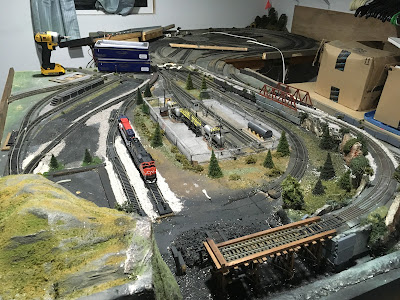This was the initial attempt. Notice the lack of homasote at the back. This would be filled in later. One great advantage to homasote is that you can easily make changes to the design. I was not happy with this attempt, I wanted to maximize the length of the run around track, and I did not like the flow into the industry sidings.
Take two. By relaying the switches I was able to gain another car length in the siding. Also the flow is much better. The missing piece of homasote is now installed. The siding to the left will be used for a small industry, and is positioned to allow for future expansion down that wall as well.
A view from the other side of the peninsula. The switch to nothing is intended to access the ramp to the coal dump. I have not decided if I like this industry or not.
A view from the end of the peninsula. I've tossed a few buildings around on the layout, but nothing is for sure yet.


























